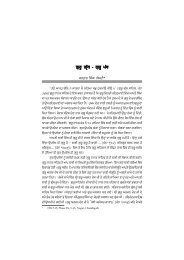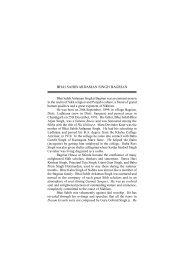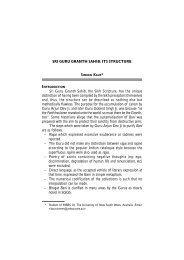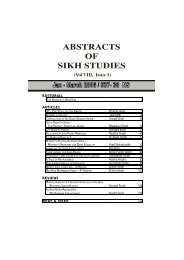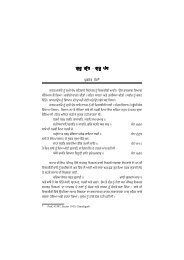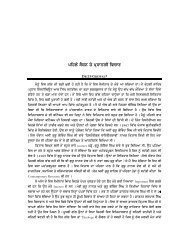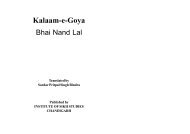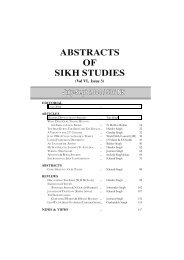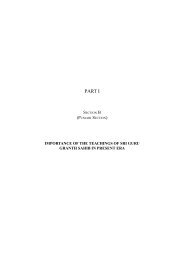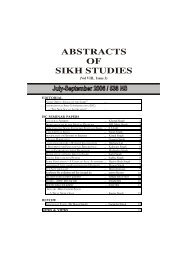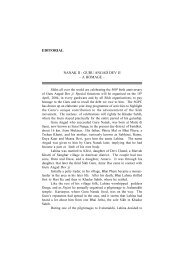editorial articles reviews news & views - Institute of Sikh Studies
editorial articles reviews news & views - Institute of Sikh Studies
editorial articles reviews news & views - Institute of Sikh Studies
Create successful ePaper yourself
Turn your PDF publications into a flip-book with our unique Google optimized e-Paper software.
106<br />
ABSTRACTS OF SIKH STUDIES : APRIL-JUNE 2005 / 537 NS<br />
wrote the first article about Guru Nanak. Bhai Mahendra Nath also<br />
wrote Guru Nanak’s biography - Nanak Prakash on the basis <strong>of</strong> Bala<br />
Janamsakhi. Going through the versions <strong>of</strong> Ritendra Nath, Krishna<br />
Kumar Mitra and Rajni Kanta, we come over to Rabindranath Tagore.<br />
He explains Khara Sauda as a “foundation <strong>of</strong> a great concept and<br />
spiritual power.” Tagore was the pioneer in introducing Bengali children<br />
to <strong>Sikh</strong> culture. Sarat Kumar Roy, Rajendralal Arya’s <strong>articles</strong>, Amodini<br />
Ghosh, Krishna Chandra Chakrabarty and Nityanand Goswami have<br />
written poems about Guru Nanak. ‘Baba Nanak was a Muslim Faqir’,<br />
writes Haq S Omed Ali, and Ali Ahmed Ali Eslambadi emphasised<br />
that Guru Nanak did namaz and was respectful to Islam. Swami<br />
Vivekananda calls Guru Gobind Singh great political leader and<br />
spiritual organizer for <strong>Sikh</strong>s but aligns him as one <strong>of</strong> the Hindu race.<br />
Rabindranath Tagore in a span <strong>of</strong> quarter century wrote a number<br />
<strong>of</strong> essays and poems about Guru Gobind Singh. All these works except<br />
one show a respectful attitude. However, in a preface to <strong>Sikh</strong> Guru or<br />
<strong>Sikh</strong> Jati, he wrote “finale <strong>of</strong> <strong>Sikh</strong> history was very tragic and tenth<br />
Guru bore the lion’s share <strong>of</strong> the responsibility for that.” By pointing<br />
an accusing finger at Guru Gobind Singh, poet’s image in <strong>Sikh</strong> psyche<br />
suffered a great dip. Even Himadri Banerjee does not justify this change<br />
in the <strong>views</strong> <strong>of</strong> Tagore, keeping in mind the voice <strong>of</strong> protest by Punjab’s<br />
oppressed rural peasantry. “So to criticize him (Guru Gobind Singh)<br />
for the communal discord in eastern India in the first decade <strong>of</strong><br />
twentieth century is perhaps an incorrect historical formulation.”<br />
Rabinderanath’s digs no doubt hurt <strong>Sikh</strong> intellectuals in distant Punjab,<br />
rues the author. Jatras, Guru Gobinda in five acts by Haranath Bose,<br />
<strong>Sikh</strong>er Katha a five-act play by Jatindranath Samadar, also criticized<br />
Guru Gobind Singh. It appears these Bengalis did not approve <strong>of</strong><br />
Guru’s Khalsa army taking up the arms for stemming Mughals’<br />
oppression and wanted Gandhi’s non-violence stance.<br />
Behold ! Subhash Chander Bose, another Bengali, did adopt armed<br />
struggle for country’s independence. Tinkari Banerjee presented in<br />
Guru Gobinda Singha, Guru’s life with references from Suraj Parkash<br />
and Dasam Granth. Banerjee Basant Kumar calls the Guru ‘a spirit <strong>of</strong><br />
protest against oppression, a religious preacher, a creator <strong>of</strong> martial<br />
race’. It is well nigh impossible to even enumerate the Bengali authors<br />
<strong>of</strong> <strong>Sikh</strong> study. Japji Sahib’s Bengali translation in 1900 AD shows



